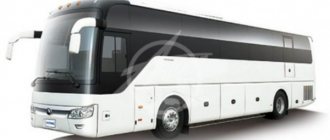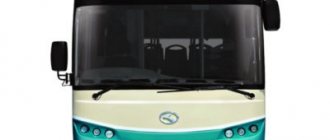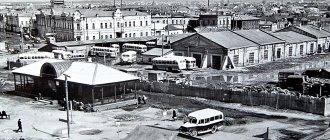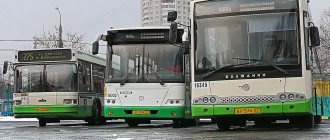From the banks of the Neman to the shores of Moscow
Andrey Filippov, photo by the author
Before the transition of JSC Lida Buses Neman in 2014 under the wing of the Minsk Wheel Tractor Plant (VOLAT), the model range of passenger vehicles of the enterprise was quite diverse. There, small-class buses “Neman 4202 Cacciamali” were assembled on the IVECO Daily and “Valdai” chassis in various modifications (“GP” No. 12, 2010), and the family of 12-meter “Neman 5201” included urban, suburban and intercity versions. Demand was small, but the company stubbornly held on to its range, surviving despite all predictions of non-competitiveness. Moreover, the very decent quality of the products made it possible to imagine the future by no means in black.
Having moved from the status of an independent plant to the status of one of the VOLAT workshops, Neman revised its model range. The presentation of new buses with the letter “N” on the “face” took place in Maryina Gorka on the territory of the branch “Vehicle Park No. 19”, which is part of Minoblavtotrans OJSC. This format was not chosen by chance - not only the management of other regional branches, but even guests from Moscow gathered to celebrate the 55th anniversary of the enterprise. VOLAT made the most of the opportunity to present its model range to transport workers by rolling out the Neman 520123 commuter bus and two Neman 4202 family vehicles to the site. Perhaps we’ll start with them...
A new style
So, before us is “Neman 420211-511” in urban configuration and “Neman 420234-511”, intended for work as a “tourist”.
First look at the bus and... where is it, the former “charm” of the highly controversial Cacciamali design?! This time, the Belarusians decided to do without the help of the Italians and entrusted the development of the exterior to their designers. For me, it turned out much more harmonious. Moreover, it seems that a “knight’s move” was made, and the task was set not just to “stick on a new pretty face”, but to create an image that would be unmistakably recognizable as the IVECO Daily of the 2015 generation, on the chassis of which the “4202” family is based. If so, then the designers deserve an “excellent” rating. Perhaps the appearance of the bus lacks originality, but, you see, at this stage it is more important to emphasize the relationship with IVECO than to demonstrate one’s ambitions, especially since the “Neman 4202 Cacciamali” never achieved great popularity in Russia, although there was plenty of originality in it .
In addition to the hood and wings, the front part of the body has also undergone modifications - the windshield has become smaller in height, and the plastic roof, on the contrary, has become a little higher. As a result, a space has appeared under the ceiling, which in the future may be used for installing shelves or installing pencil cases with 2-DIN slots.
For better maintainability, the rear wall now has separate blocks of lights located in the most “impact-dangerous” places - previously they were made as a single element and it was expensive to change them in the event of an accident.
The body itself has been tested by real use and has proven its practicality and viability even in the previous generation. Moreover, at one time “NEMAN” even assembled a batch commissioned by Cacciamali, so, keeping in mind the saying “the best is the enemy of the good,” the concept of the body remained unchanged. And judging by the information provided, the wheelbase has increased by 430 mm, the front overhang has increased by 280 mm, and the rear overhang has increased by 30 mm.
Do not forget that now to create small-class buses, VOLAT uses a more load-bearing IVECO Daily 70C17 chassis with air suspension. Together with an increase in overall length by 740 mm, the total passenger capacity of the city bus is increased to 44 people, and in the tourist version, while maintaining the same number of rows of seats, more comfortable Turkish-made seats are installed.
By the way, there are also changes in the interior. If in the “tourist” “Neman 420234-511” they are rather cosmetic - higher quality materials, different design, then the urban “Neman 420211-511” received a completely different layout.
In accordance with market trends, the area opposite the 2nd service door is given over to a place for transporting a wheelchair user. For this purpose, a folding ramp is mounted on the floor, and the air suspension has a kniling function. In the absence of a stroller, the entire rear part of the cabin turns into a storage area, and taking into account the central aisle of an acceptable width, the bus can carry 24 passengers while standing.
In general, both cars left a pleasant impression precisely because of their attention to market demands. However, work on them is not finished yet, so we are waiting for the first commercial samples.
Bus "Neman". Guest from the past
Suburban Neman-520123 is an unusual bus. A kind of embodiment of the popular Ikarus 250 in the USSR in a modern interpretation. Among the advantages of this bus from Belarus are high maintainability and relatively low price.
Mikhail Ozherelev
Neman-520123-260. Overall length: 11.65 m. Start of sales: 2015 Price: RUB 6,500,000.
Externally, suburban Neman-520123 looks quite attractive
Compared to its competitors from Russia and abroad, this model is perceived as a guest from the past, but there is a logical explanation for its appearance on our market right now. Until recently, the products of the automobile assembly JSC MZKT (produces city, suburban and intercity buses) were addressed to local carriers and transport companies in neighboring Ukraine. But now, due to the difficult economic situation, Belarusian bus manufacturers are thinking about expansion in the Russian market, where the Neman-4202, a small class bus on the Iveco Daily chassis, is selling quite well.
The dashboard is the place where the present and the past coexist
The Neman-520123 model went into circulation in 2014, production in Belarus is organized in a full cycle. The bus has an original design, although it is incorrect to recognize it as a complete “original”. For example, parameters such as wheelbase, track width, suspension design, etc. were borrowed from the LiAZ-5256 bus (until 2003, large-unit assembly of LiAZs was carried out at the plant, see the sidebar for details).
REJUVENATION PROCEDURE
The 12-meter Neman-520123 looks much nicer and more modern than its Russian counterpart. This is supported by panoramic glazing with tinted double-glazed windows, a large continuous windshield, smooth shapes of the front mask, a wide front route indicator and new block headlights borrowed from MAZ trucks. The suburban model has two single-leaf doors - in the rear overhang and opposite the driver.
The main fasteners for plastic are ordinary self-tapping screws
The body is of a carriage type, its supporting frame is welded from rectangular steel pipes with a lattice-truss structure base and lined with galvanized steel sheet. The front and rear masks are fiberglass. The load-bearing frame, including the internal cavities of the pipes, is treated with a protective anti-corrosion compound, and the bottom and wheel arches are also treated with noise-absorbing mastic.
Handbrake valve
The commuter bus with improved comfort is designed to carry 70 passengers. The cabin floor is located at a height of 75 cm, and to get to this level you need to climb three steps. In the cabin, on podiums there are 44 separate passenger seats with a high reclining backrest, fabric upholstery and armrests. There are neat curtains on the windows. The seats are installed in such a way that the distance from the front seat cushion to the back of the chair in front is always the same, regardless of the row of seats. The exception is the back row: here the seats are placed on a separate pedestal. In general, this arrangement is morally outdated, but it is still quite suitable for a commuter bus. The ceiling height in the cabin is 2110 mm. There are luggage racks above the seats, and there are two compartments in the lower belt for large hand luggage. True, their total volume is small - only 0.9 m3. This is a minus.
The engine brake is activated by a separate pedal
A comfortable temperature during the journey is ensured by a Diavia roof-mounted air conditioner with a power of 25 kW; its air ducts are mounted in the luggage racks and direct the flow of coolness mainly to the central aisle, and not to the passenger seats - apparently, it was decided to save money on individual service units. The passenger compartment is heated by means of five air heaters and convector batteries, which are located along the sides. In winter, the coolant is heated using an autonomous Spheros heater with a power of 23.3 kW, included in the engine cooling system circuit.
The driver's workplace is separated from the passenger compartment by a solid partition.
The back of the passenger seat reclines at a significant angle
In general, it is noticeable that the designers took care of the crew. At least it's spacious and everything is at hand. The driver's seat with Belarusian-made air suspension has a wide range of settings. In combination with an adjustable steering column (made by MZKT, judging by the logo), this allows the driver to sit comfortably at the workplace. The rear view mirrors are located in optimal areas. The “poker” of the gearbox causes some inconvenience to the driver - it is located in a narrow passage on the way to the seat. However, you can adapt to this; it won’t take much time.
There are 44 separate passenger seats with a high reclining backrest on podiums in the cabin.
The two-point belt was surprising. Agree, a bus driver fastened like a passenger will always arouse suspicion among our attentive traffic police officers. But the technical regulations of the Customs Union allow the use of such belts, and the bus is certified. By the way, those who plan to use a Belarusian car on commercial routes should take into account that the basic configuration does not have a tachograph - this device will have to be ordered from the dealer for an additional fee.
For those who ride standing, handrails are provided
The dashboard is another place where past and present contrast. The latest multifunctional display, displaying the operating parameters of the power plant, is adjacent to archaic dial instruments: fuel level indicator, speedometer and pneumatic system pressure gauges. The control lamp block inherited from LiAZ was moved to the right sector of the center console, and the lighting control was located on the left side. The dashboard materials are simple and unfussy, but the build quality is good. The parking brake is actuated by a KAMAZ valve - it is located to the left of the driver, and a separate pedal is provided to control the engine brake. True, it is located poorly - under an outstretched leg, and this must be taken into account when adjusting the seat.
MARKETING FORMULA
The main feature with which the creators of the bus are going to conquer the Russian market is the imported component base: Deutz TCD2013 power unit (290 hp, Euro-4, SCR), 6-speed ZF 6S 1200 gearbox and Raba 718.75 drive axle gear ratio 5.44. The manufacturer considers this combination optimal in terms of reliability and operating costs. The power unit is installed longitudinally in the rear overhang, and the radiator of the cooling system is installed transversely. The fan drive uses a viscous coupling and an angular gearbox. Access to the power plant is available both through the rear hatch and through removable panels in the cabin. Moreover, the vertically raised rear hatch is equipped with a limit switch, which prevents the power unit from starting from the cab during its maintenance. But you can also start the engine from a special remote control in the engine compartment. All service points are freely accessible. Certain inconveniences can be created by the insufficient lifting height of the rear hatch - tall people will have to bend down.
Air conditioning ducts are installed in the luggage racks
In terms of driving sensations, everything is predictable. Noise level, dynamics, clarity of gear shifting, operation of the air suspension - according to these parameters, the passenger car clearly corresponds to its purpose. There is nothing unusual when slowing down - the same familiar drum brakes with ABS and ASR. I would like a little better ride smoothness, but one can hardly expect more from the dependent front suspension with two air springs.
Luggage compartment volume 0.9 m3
But, as it turned out, the main “highlight” of the bus is not even the imported power unit or gearbox. The plant's marketers relied on a low price. A commuter bus of improved comfort with a Deutz engine and ZF 6S 1200 gearbox costs only 6.5 million rubles. The low price plus imported components and decent build quality indicate that Neman buses are able to occupy their niche in the Russian market. True, for this it is necessary to expand the network of dealer and service centers. And if these problems are solved in the near future, Belarusian buses have every chance of finding their consumers in Russia.
Front air suspension with A-frame
Deutz diesel engine with SCR system complies with Euro-4 standards
FROM THE HISTORY OF THE BRAND
The Lida Automobile Assembly Plant was founded in May 1984. It was created as an enterprise of the USSR Ministry of Radio Industry for the production of mobile control systems. The plant was supposed to provide assembly and warranty service for a variety of wheeled military missile technology. In 1992, as part of the conversion program, the enterprise switched to the production of civilian products, starting the assembly of buses of the LiAZ-5256 type. It is interesting that the initiative to assemble LiAZ vehicles in Belarus came from the Russian side, and before the start of large-scale assembly of buses, Neman specialists were trained in Likino-Dulevo, Moscow region. Production of LiAZ vehicles continued until 2003. On December 24, 2010, PRUE “Opytny” was reorganized into JSC Lida Buses Neman, and in 2015 the company became a branch of JSC MZKT. Its modern name is the branch of Automobile Assembly OJSC MZKT. Currently, medium and large class buses are produced - a total of seven models.
- High maintainability, low price
- Small volume of luggage compartments, poor placement of the engine brake pedal, difficult access to the engine compartment
| Specifications | |
| Passenger capacity, persons | 70 |
| Number of seats | 44 |
| Curb weight, kg | 10 445 |
| Total weight, kg | 18 000 |
| Dimensions (length/width/height) mm | 11 655/2550/2975 |
| Wheelbase, mm | 5840 |
| Fuel tank volume, l | 320 |
| Engine: | |
| model | Deutz TCD, Euro 4 |
| type | diesel, in-line, 6-cylinder |
| working volume, l | 7,14 |
| power, l. With. at min-1 | 290 at 2050 |
| torque, Nm at min-1 | 1200 at 1050–1650 |
| Transmission | ZF 6S 1200 |
| Suspension: | dependent, pneumatic |
| Brakes | drums |
| Tires | 275/70R22.5 |
| Service | |
| Factory warranty | 1 year or 60,000 km |
| Service mileage | 20,000 km |
| Price | |
| Basic/tested bus, rub. | 6 500 000 |
| Competitors | |
| LiAZ-5256, MAZ-231062, NefAZ-5299-011-31 | |
The editors recommend:
Why do piston rings stick and how to prevent it?
A traffic police officer searched my car: did he have the right to do so?
Russians may be left without foreign cars: Western automakers have stopped supplying cars to our country
A ship that was transporting cars to Russia was detained in France
Half of the car factories in Russia have closed
Discussion Cancel
Reincarnation
But the situation with “Neman 520123” is not so rosy, although there is some progress in this project.
It makes no sense to hide that the 12-meter is based on the LiAZ-5256 family with all its pros and cons. Over the years of development on Belarusian soil, the “5201” model has undergone several modernizations, both in appearance and technical content. The main engine is now a 290-horsepower Deutz, and is paired with a ZF manual gearbox. Other components have also been revised to make them more reliable, albeit more expensive. However, the years have taken their toll, and high-floor, high-capacity city buses have become uninteresting even to the poorest enterprises, so the only refuge for the model is now routes outside cities.
To be impartial, the presented configuration of “Neman 520123-260” is not quite a commuter bus in the sense that they put into it. The cabin is equipped with chairs with the ability to change the angle of the backrest. There are spacious overhead compartments for hand luggage, and the car is optionally equipped with cabin air conditioning. The result is an intermediate option, which in terms of comfort is worthy of working on intercity routes with a distance of 200–300 km, but its access to them is slowed down due to the size of the luggage compartment under the floor. Even despite the increase due to the space under the podiums, its capacity is still insufficient.
Rocket Bus
The fact that the company involved in rocket carriers has not only not curtailed bus production, but is also striving to develop it, speaks volumes. Yes, the Valdai topic was finally closed; Yes, the production of urban 12-meter ones has been curtailed, but all efforts are now invested in updating the Neman 4202 family. By the way, the last point is connected not only with the release of the new generation IVECO Daily, but also with the fact that the Russian representative office of IVECO turned out to be very interested in cooperation with Neman, and not using the support of such a strong player is an unforgivable luxury.
Of course, it’s too early to say how much Russian carriers will like the new generation - we need to wait for the end of certification tests and a specific price tag. But the tandem of VOLAT and IVECO can turn out to be a very serious force, especially if supported by a competent price / quality ratio...
A new original bus on the
IVECO Daily .
Manufacturer: branch of MZKT
in Lida. We present the details of the project.
Only transport specialists and “fans” who are interested in the topic of buses know that buses are made in Lida. And most Russians will only ask: “Where is Lida, and what?”
01.
The regional center of Lida, Grodno region, is not particularly famous for anything outside the Belarusian border. But almost every Belarusian will tell you that the best beer and kvass in the country are brewed in Lida. Local historians, of course, will immediately remember the local tourist attraction - Lida Castle.
02.
- a local, non-tourist, but industrial attraction.
The former defense “mailbox”, which dealt with special radio equipment for various types of military equipment of the Soviet army, is now an automaker, a partner of IVECO
and a “vassal”
of MZKT
.
Let's try to briefly trace the path of the Neman
"from radio stations on armored personnel carriers to elegant buses by our historical
Remarque
.
Remark by M-Park
After the collapse of the USSR, the plant, in order not to disappear completely, had to switch to the production of... gas burners, fans and some other little things... PAZs and GAZelles were assembled here, but the plant survived by purchasing a license to manufacture the LiAZ-5256
.
03.
Gradually,
LiAZ-5256
turned into its own model
Neman-5201
, which has been a hit since the early 2000s class=”aligncenter” width=”1050″ height=”646″[/img]
04.
Then we turned to the theme of small class buses.
In the summer of 2006, the experimental Neman-3231
.
on the Dongfeng
. The matter did not go beyond one collected sample.
05.
It turned out to be much more profitable to collect small “Chinese” companies under license.
Neman-3232
is nothing more than a thoroughly localized
Changchun CCJ6660D
.
It was also based on the Dongfeng EQ6590KS
, and they made the bodies themselves according to the Chinese model. This product was mass produced.
06.
In parallel with the Chinese one, we also worked on the European vector of bus cooperation on the topic of small class.
They worked so successfully that in the future it will be buses on the IVECO Daily
that will become the main “breadwinners” class=”aligncenter” width=”1050″ height=”516″[/img]
Pedigree " Nemanov
"small class" has its roots in the town of Mairano in northern Italy, where the "body" company
Cacciamali SpA
07 is based.
Atelier
Cacciamali SpA
is a fairly well-known manufacturer of bus bodies in Europe, and its model
Cacciamali Thesi
“model 1998” on the
IVECO Daily
was even purchased by Mostransavto in the first half of the 2000s.
At Cacciamali SpA
in Poland there is a “daughter” - the company
Kapena SA.
He began collaborating with the Polish “daughter” of the Italian bodywork company in 2007.
Kapena Thesi
bus arrived in Lida from Poland , which became a model for future products.
08.
The residents of Lida also became friends with their Italian hosts.
Neman Cacciamali
appeared on board .
The assembly of this model in Lida was successfully completed. The bus went into production under the designation Neman-42012
.
Next, at Cacciamali
The production program has been updated.
As a result, in 2010, the second generation of Lida small class buses was born, which is a complete licensed copy of the Cacciamali Thesi
of the next generation, new at that time.
09.
The Italian-Polish-Belarusian bus in the intercity version was designated
Neman-420122
, the city bus -
Neman-42011
, the school bus -
Neman-42013
.
10.
It is curious that a trial batch of Belarusian-made bodies was sent to Italy to the “parent” company, where the quality was approved and they were turned into complete buses sold to European customers.
In April 2014, fate took a new turn. By state decision, the plant was included in the MZKT
, and from that moment the Lida enterprise was called
the Auto Assembly Branch
.
11.
This is how a curious juxtaposition of identification plates was born.
Who would have thought that the abbreviations MZKT
and
IVECO
would live side by side on the same car? However, it’s a fact.
During this time, the base chassis was modernized, and the bus index also changed. New designation Neman-4202
replaced the previous
Neman-4201
.
12.
This is the intercity
Neman-420224-11
, released under the auspices
of MZKT
.
The external difference is slightly different headlights from
the 2011 IVECO Daily
“Round-eyed” Neman-4202
- is still the basis of the production range, but a replacement has been prepared.
The design bureau MZKT
.
The basic index of the Neman-4202
did not change, the numerical differences were only in the prefixes.
13.
The rear lighting equipment was left unchanged, but was “framed” with a black trim.
On the left is Neman-420224-11
of the old model, on the right is
Neman-420234-511
of the new one.
14.
The “nose” has been redesigned many times more thoroughly. It has become longer because there is a more powerful engine under the hood. Previously, a 146-horsepower engine was installed, now - a 170-horsepower one.
15.
Compare the newest “reading” of the same bus performed by
Cacciamali
(left) with the version that was made at
MZKT
.
16.
IMHO, the Belarusian version is more stylish and expressive.
17.
The plastic parts for the new front mask are made entirely ourselves, in Lida.
18.
The windshield is original, supplied by Mogilev.
So far, three copies have been collected - tourist, intercity and urban. We met "Tourist" and "City Dweller".
19.
This is "Tourist".
Its index is Neman-420234-511
. The wheelbase has been increased by 400 mm compared to the previous one.
20.
"Citizen" is designated by the index
Neman-420211-511
. A distinctive feature of the urban version is a wide sliding door in the rear overhang.
21.
Behind it there is a decent-sized storage area with space for a wheelchair. You can enter the salon using a wheelchair using a ramp.
22.
The total passenger capacity of the city version is 44 people. Number of seats - 20.
23.
The tourist version has 28 seats.
In this case, the chairs used are Turkish, from SEGE
.
24.
The engine is a 3-liter turbodiesel
IVECO F1CFL411
Euro-5 level. Let us remind you that it has increased power - 170 hp. versus the previous 146 hp.
25.
The interior of the driver's workplace has been carried over from
IVECO Daily
.
26.
Currently, new buses are undergoing run-time and acceptance tests, the results of which will result in OTTS. And then…
And then competition in the segment will increase. But competitors are also strong. About them - little Remarochka
.
M-Park's remark
27.
The main competitor is, of course,
VSN-700
, which is made by
ST-Nizhegorodets LLC
. There are hundreds of such buses in Moscow alone. They began to appear in other regions of the Russian Federation.
28.
The second strong competitor also comes from the Nizhny Novgorod province.
Foxbus 22501
is a product
of Innovative Technologies LLC
from the city of Vorsma. Their circulation is smaller, but there are at least dozens of copies built.
In terms of design, they are all beautiful. This means that it will also be necessary to shine with the quality of workmanship, and with this at MZKT
just extremely strict.
29.
Of course, it will be necessary to “play” not only with quality, but also with price, and Belarusians also know how to do this.
The appearance of the car was stylish and memorable. But most importantly, this is not a converted “vanbus”, but a passenger vehicle with an absolutely original body, designed “from scratch” according to all bus “canons”.
MZKT marketers
They plan to sell at least about a hundred of these buses a year in the CIS. Perhaps there is every chance of this.










